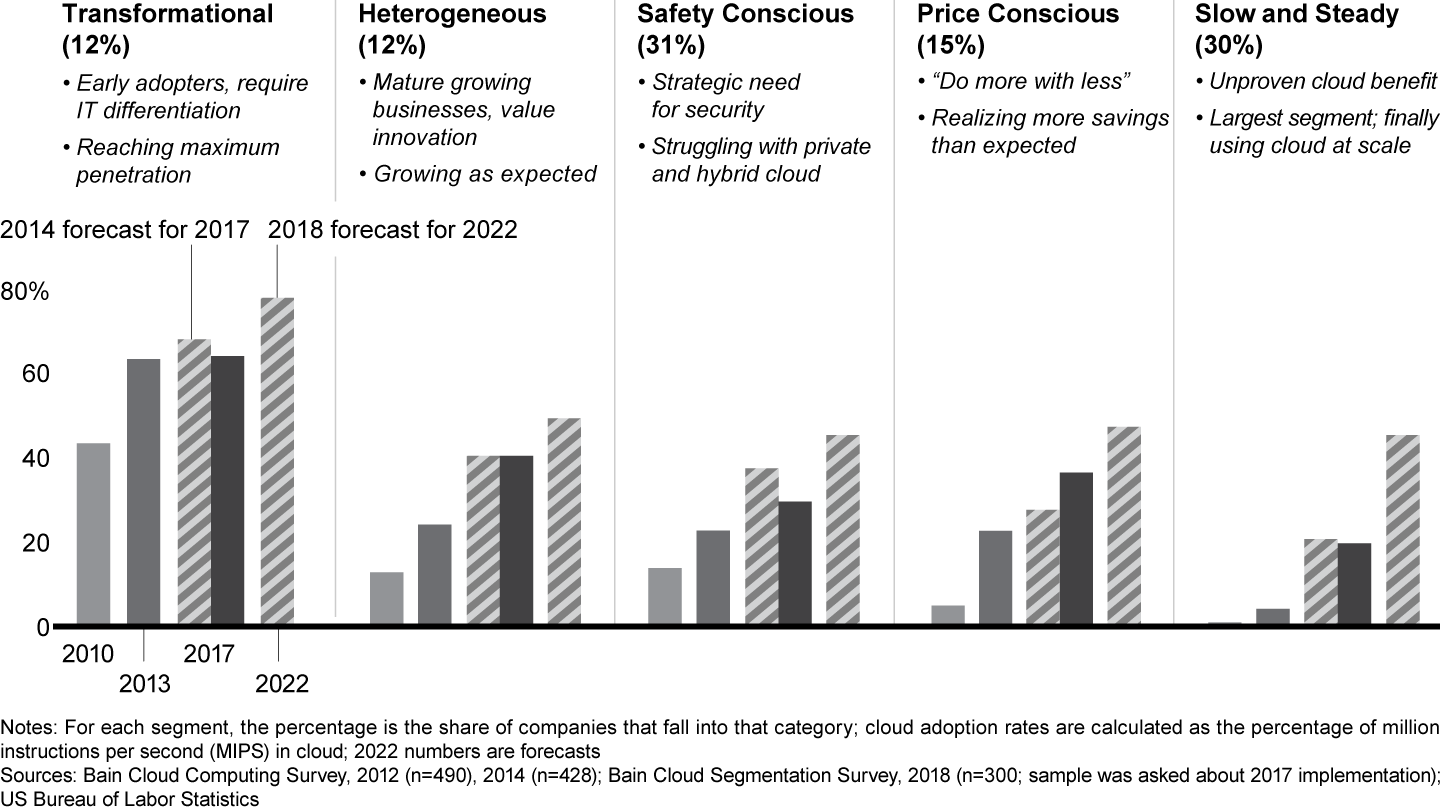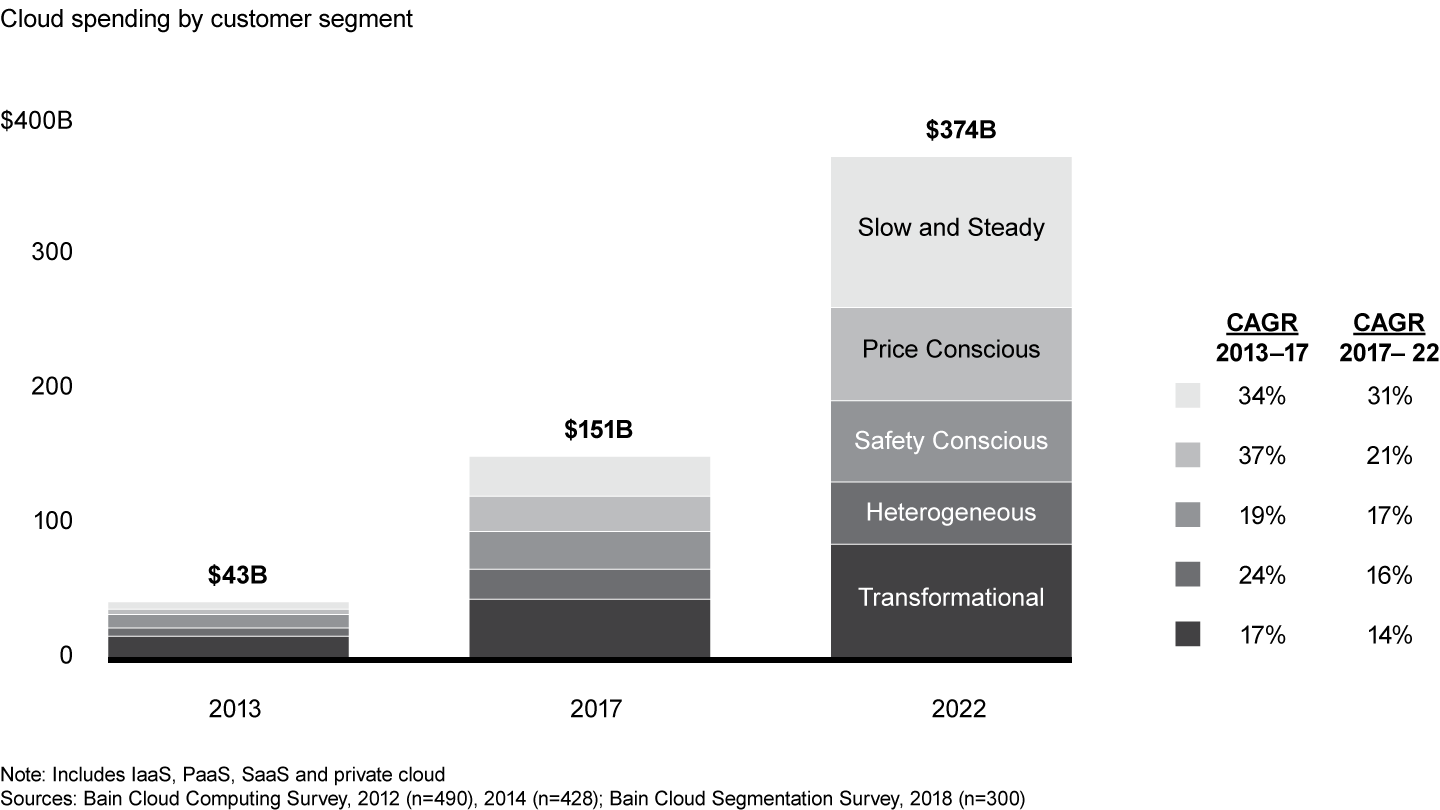Article

This is the second in a series of posts on the enterprise cloud market—its economics, customer segments and the opportunities for technology providers.
Cloud sales may be through the roof, but technology vendors that pursue the market with a one-size-fits-all approach are liable to fall short of their ambitions.
Enterprise customers have achieved the predicted levels of cloud adoption (33% of their workload in the cloud by 2017, just as they estimated in 2013) and have raised their expectations for future adoption rates, seeing half of their workload in the cloud by 2022. Adoption has been spurred on by the ever-expanding growth and diversity of cloud offerings, both functional and industry specific, including mobile app development, Internet of Things applications, AI and data storage. Declining costs are proving to be a tailwind.
But adoption rates vary widely depending on the business context, decision-making philosophy, workload characteristics and underlying cloud economics (see Figure 1). While there’s still significant headroom in the market, the early movers may have hit a ceiling, and many customers still wrestle with the cost and complexity of cloud solutions.


To help sellers make sense of the market, Bain developed five customer segments based on adoption behavior: Transformational, Heterogeneous, Safety Conscious, Price Conscious and Slow and Steady. These five faces of the cloud, which we first identified in 2011, are still a useful way to delineate markets and are a powerful tool for determining the right value proposition in line with customers’ strategic goals (see Figure 2).


Transformational. These early adopters continue to set the bar for the market, but some are reaching a plateau in adoption. Transformational customers have sought out innovative offerings with good support, and many are digital-first companies. Their quest for a distinctive edge has motivated them to buy the cloud for performance and scalability, and they focus less on cost savings than many other customers. But some are discovering the limits of cloud penetration, where the economics or need for low-latency begin to favor on-premise computing. For example, a predictable workload running consistently at 80% utilization would lead a rational CIO to opt for on-premise.
Heterogeneous. The diversity of existing IT environments and workloads leads these customers to take a more measured pace of adoption. Many are mature businesses with forward-looking CIOs eager to adopt cloud—but at rates that ensure they can deliver on expectations. These customers have segmented their existing workloads according to needs and opportunities, moving some to software as a service (SaaS), others to a variety of infrastructure- and platform-as-a-service (IaaS and PaaS) providers, while maintaining some on premise.
Safety Conscious. Cloud adoption continues to increase for these customers, although at a slightly slower pace. Companies in this segment moved only half as much of their workload to the cloud as they had expected, primarily because the private cloud offerings they demand have fallen short. Demand is apparent, but safety-conscious customers require a private, dedicated cloud environment for most of their cloud applications, and these have proved too costly or too complex, limiting uptake. If providers can improve their private cloud offerings and make it easier for these services to work smoothly with the public cloud, they will find greater opportunity in this segment.
Price Conscious. Cloud adoption by price-conscious customers has outstripped expectations as they pursue the economic benefits of moving to the cloud. These customers have proved the most sophisticated at transforming their technology environments to capture the greatest savings. When companies merely “lift and shift” as they migrate their workloads to the cloud, executives are often disappointed when cost savings don’t materialize. A more effective strategy is to approach migration as an opportunity to assess computing and storage practices throughout the company. These assessments can uncover a great deal of fragmentation and duplication, with workloads scattered across machines and data centers. Our experience shows that companies that rightsize their workloads can cut costs by as much as 30% to 60% when they migrate them to the public cloud (see the Bain Brief “Rightsizing Your Way to the Cloud”).
Slow and Steady. Most of the growth in cloud adoption will come from these customers, as they become the largest segment in cloud spending by 2022 (see Figure 3). These buyers waited on the sidelines while early adopters tested the waters, but have waded in over the past three to five years. Half the growth in cloud spending comes from this group. For cloud technology providers searching for growth from the cloud, this is the category to focus on.


At a time when some segments have hit a peak and others are struggling to achieve ambitions, it’s more imperative than ever for providers to define their target segment and focus to win. A rising tide lifts all boats, but in this case it won’t lift them all evenly.
Mark Brinda and Kate Woolley are members of Bain & Company’s Global Technology practice. Both are based in the firm’s New York office.